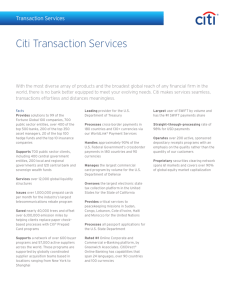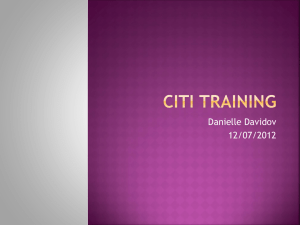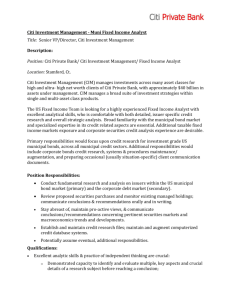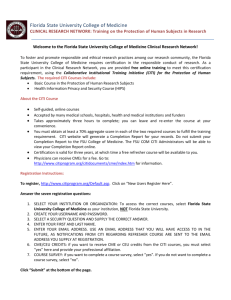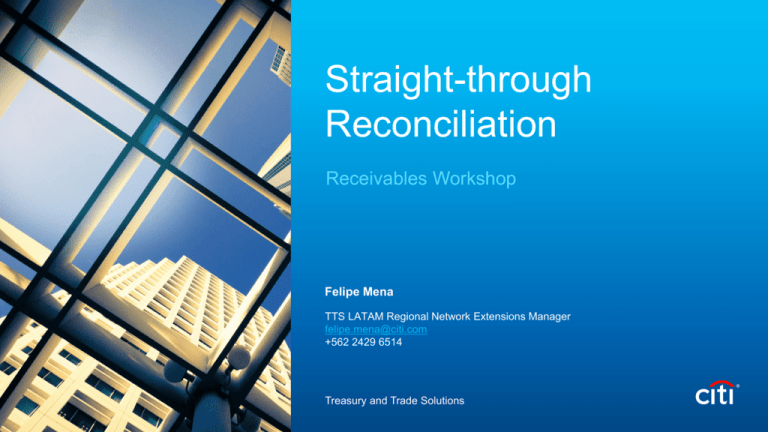
Straight-through
Reconciliation
Receivables Workshop
Felipe Mena
TTS LATAM Regional Network Extensions Manager
felipe.mena@citi.com
+562 2429 6514
Treasury and Trade Solutions
1. Introduction
2. Background on Straight-through Reconciliation
3. In Motion Steps to Straight-through Reconciliation
Introduction
Workshop Objectives
– Understand Straight
through Reconciliation (STR)
– Understand key Receivables
components that impact Straight
through Reconciliation
Felipe Mena
Network Extensions, Strategic Alliances and Int'l Cash
Regional Manager
Leads Network Extensions Strategy, Aggregator Project, RDC,
ICLs, Lockbox, LCY Remote Deposits, CDMs and
Capability Grid
Felipe joined Citi in 2011. He has more than 15 years of experience in the
commercial and marketing areas of technology companies working in electronic
collections and payments solutions for the Financial Industry and Corporate
segment. Before joining Citi he was the Commercial Manager for payments and
collections solutions for Argentina, Panama and Colombia in a Chilean company.
– Learn necessary steps to increase
your STR ratio
Before that he was responsible for the development of electronic receivables
solutions for Claro, Nextel, Telmex, Insurance Companies and Universities.
He has a degree in Marketing from Universidad Catolica de Chile and a Master in
Sales Management from Universidad Adolfo Ibañez in Chile
3
1. Introduction
2. Background on Straight-through Reconciliation
3. In Motion—Steps to Straight-through Reconciliation
About STR and Key Performance Indicators (KPIs)
STR increases visibility and control through the working capital cycle and completes the cash flow
cycle reducing human operations
Benefits
– Improved DSO1
Order
Fulfillment
Rate
– Quicker cash application
– Freeing customer credit lines for
more business
Customer
Service
– Effective working capital management
– Reduction in internal costs, such as
customer service, dispute management,
order fulfillment
– More precise end-to-end cash forecasting
1Days
5
Sales Outstanding
Sales
STR
Ratio
DSO
DSO’s Variation Across Industries
DSO stands for the number of days taken by a company to collect payments from completed sales.
Poor receivables management is reflected in high DSO and effects the company’s access to internal funding sources.
Industries with complex supply chains
and global operations typically have the
largest potential working capital savings
DSO is influenced by geography where
for example commercial terms and/or
debtor behavior tends to be more relaxed
160
140
120
DSO
These companies have trapped liquidity
which they could unlock by moving to
their industry median
180
100
80
60
40
20
0
Consumer &
Health
Minimum
Median DSO
Energy, Power
& Chemicals
Industrials
Technology,
Media, Telecoms
Maximum
For a company with a turnover of US$14.3 billion, decreasing average
DSO by one day has a positive impact of US$39 million
6
Receivables Impact on Organizations
Key stakeholders have various interests relative to Receivables any solution needs to balance
their needs.
Finance Manager
Sales
Credit Collections
Reduce DSO
Payers convenience
Cost savings
Expand sales
opportunities
Payment receipts
and dishonours
Better control
Claims/Dispute Team
Payments and
dishonours
Minimized credit utilization
7
Treasurer
Faster and Predictable
Cash Inflow
Minimized credit utilization
AR Manager
Easy reconciliation
increase level of
automation, less exceptions
SSC Manager
ERP and Tech Team
Customer Service
Efficiency
Standardization
Consolidated,
easier reporting
Increase customer
service level
Automation
Formats
Freeing credit lines
Inside Receivables
Receivables is made of a series of processes that interact with different parts of the organization
within your company and your clients.
Check
Inventory
Update
A/R
Cash
Application
Accept
PO
Deliver
Good/Service
Issue
Invoice
Open
AR
8
Buyer
Seller
PO
Receipt
Payment
Receipt
Payment
Initiation
Invoice
Approval
Invoice
Review
Understanding Payers
Not every payer uses the same collection channel. Payers characteristics and size can help
determinate the probable channel they may use.
Payer Tier
Company Size
Top Tier
Company
Low
Volume
Payment Method
ACH
High
Value
Collection Solution
eIPP
Invoice Presentment
and Payment
ACH
Middle Tier
Small and Mediumsized Distributors/
Company
Low Tier
Small Shops
9
Transaction Type
Mid
Value
Mid
Volume
Low
Value
High
Volume
Checks
Deposits
Branch Network
Cash
Deposits
Network Extension
Collection points
Checks
Deposits
Remote Deposit
Capture Check
Collections
Cash
Deposits
Mobile Collect
Corporate
Client
How Does Your Collections Map Looks Like
Payer Tier
Top Tier
Company
Trx
$
10% 55%
Middle Tier
Small and Mediumsized Distributors /
Company
Trx
Collection
Channel
$ Collections
Share
Payment
Method
$
Trx
Bank 1
30%
ACH
88%
55%
Checks
12%
45%
Bank 2
70%
Checks
100%
100%
Bank 1
60%
ACH
60%
70%
Checks
30%
20%
Cash
10%
10%
Checks
80%
90%
Cash
20%
10%
Checks
60%
30%
Cash
40%
70%
Checks
45%
40%
Cash
65%
60%
Checks
100%
100%
$
30% 30%
Collections Agency
40%
Corporate
Client
Bank 1
Low Tier
Small Shops
Trx
20%
$
Collections Agency
50%
60% 15%
Sales / Drivers
10
30%
Transaction Integration … The Last Mile
Citi’s broad range of solutions, superior integration capabilities, and flexible delivery channels enable the bank to create
an enhanced reconciliation solution that offers immediate, mid-and long-term benefits.
Intra Day (Operational) vs. End
of Day Receivables
(Financial) Reconciliation
Intra Day (Operational):
Is about capturing the correct
transaction data for every
collection item paid during
an operating day
End of Day (Financial):
Is about effectively matching
every collections transaction
against account
statements/ledgers
From Detailed Information Capture …
Distributors
To an Enhanced
Reconciliation Process
e-IPP
Remote deposit
capture
Citi mobile collect
Distributors and
Individuals
Over-the-counter
solutions
CDMs
Distributors and
Individuals
CitiConnect
CitiDirect
BE
Unified
Collections
Reporting
SDD Argentina
Virtual accounts
ARMS
Note: SAP is the trade name of SAP SE (or an SAP affiliate company) in Germany and other countries. The SAP logo is a trademark of SAP SE (or an SAP affiliate company) in Germany and other countries.
11
Finding the Right Match
Companies must find the right match between payer behaviors and their needs, which range from
price, processing time, availability of funds and information among others.
Companies
Easy and fast processing
Low transaction cost
Information availability
Funds availability
Reliable transactions
12
Payers
Convenience
(location, open hours, availability)
Late payments
Detailed bill
Fast application
1. Introduction
2. Background on Straight-through Reconciliation
3. In motion—Steps to Straight-through Reconciliation
In Motion: Steps to Straight-through Reconciliation
We have covered the basics ingredients and components of Receivables. In order to achieve STR you should follow
this five steps process. Follow this path in order to increase your Receivables automation ratio.
Define goals
Prioritize quick wins
Communicate
Measure
14
f
IRS Circular 230 Disclosure: Citigroup Inc. and its affiliates do not provide tax or legal advice. Any discussion of tax matters in these materials (i) is not intended or written to be used, and cannot be used or
relied upon, by you for the purpose of avoiding any tax penalties and (ii) may have been written in connection with the "promotion or marketing" of any transaction contemplated hereby ("Transaction").
Accordingly, you should seek advice based on your particular circumstances from an independent tax advisor.
In any instance where distribution of this communication is subject to the rules of the US Commodity Futures Trading Commission (“CFTC”), this communication constitutes an invitation to consider entering
into a derivatives transaction under U.S. CFTC Regulations §§ 1.71 and 23.605, where applicable, but is not a binding offer to buy/sell any financial instrument.
Any terms set forth herein are intended for discussion purposes only and are subject to the final terms as set forth in separate definitive written agreements. This presentation is not a commitment to lend, syndicate a
financing, underwrite or purchase securities, or commit capital nor does it obligate us to enter into such a commitment, nor are we acting as a fiduciary to you. By accepting this presentation, subject to applicable law or
regulation, you agree to keep confidential the information contained herein and the existence of and proposed terms for any Transaction.
Prior to entering into any Transaction, you should determine, without reliance upon us or our affiliates, the economic risks and merits (and independently determine that you are able to assume these risks) as well as the legal,
tax and accounting characterizations and consequences of any such Transaction. In this regard, by accepting this presentation, you acknowledge that (a) we are not in the business of providing (and you are not relying on us
for) legal, tax or accounting advice, (b) there may be legal, tax or accounting risks associated with any Transaction, (c) you should receive (and rely on) separate and qualified legal, tax and accounting advice and (d) you
should apprise senior management in your organization as to such legal, tax and accounting advice (and any risks associated with any Transaction) and our disclaimer as to these matters. By acceptance of these materials,
you and we hereby agree that from the commencement of discussions with respect to any Transaction, and notwithstanding any other provision in this presentation, we hereby confirm that no participant in any Transaction
shall be limited from disclosing the U.S. tax treatment or U.S. tax structure of such Transaction.
We are required to obtain, verify and record certain information that identifies each entity that enters into a formal business relationship with us. We will ask for your complete name, street address, and taxpayer ID number.
We may also request corporate formation documents, or other forms of identification, to verify information provided.
Any prices or levels contained herein are preliminary and indicative only and do not represent bids or offers. These indications are provided solely for your information and consideration, are subject to change at any time
without notice and are not intended as a solicitation with respect to the purchase or sale of any instrument. The information contained in this presentation may include results of analyses from a quantitative model which
represent potential future events that may or may not be realized, and is not a complete analysis of every material fact representing any product. Any estimates included herein constitute our judgment as of the date hereof
and are subject to change without any notice. We and/or our affiliates may make a market in these instruments for our customers and for our own account. Accordingly, we may have a position in any such instrument at
any time.
Although this material may contain publicly available information about Citi corporate bond research, fixed income strategy or economic and market analysis, Citi policy (i) prohibits employees from offering, directly or indirectly,
a favorable or negative research opinion or offering to change an opinion as consideration or inducement for the receipt of business or for compensation; and (ii) prohibits analysts from being compensated for specific
recommendations or views contained in research reports. So as to reduce the potential for conflicts of interest, as well as to reduce any appearance of conflicts of interest, Citi has enacted policies and procedures designed to
limit communications between its investment banking and research personnel to specifically prescribed circumstances.
© 2015 Citibank, N.A. All rights reserved. Citi and Citi and Arc Design are trademarks and service marks of Citigroup Inc. or its affiliates and are used and registered throughout the world.
Citi believes that sustainability is good business practice. We work closely with our clients, peer financial institutions, NGOs and other partners to finance solutions to climate change, develop industry standards, reduce our own
environmental footprint, and engage with stakeholders to advance shared learning and solutions. Highlights of Citi’s unique role in promoting sustainability include: (a) releasing in 2007 a Climate Change Position Statement, the
first US financial institution to do so; (b) targeting $50 billion over 10 years to address global climate change: includes significant increases in investment and financing of renewable energy, clean technology, and other carbonemission reduction activities; (c) committing to an absolute reduction in GHG emissions of all Citi owned and leased properties around the world by 10% by 2011; (d) purchasing more than 234,000 MWh of carbon neutral power for
our operations over the last three years; (e) establishing in 2008 the Carbon Principles; a framework for banks and their U.S. power clients to evaluate and address carbon risks in the financing of electric power projects; (f)
producing equity research related to climate issues that helps to inform investors on risks and opportunities associated with the issue; and (g) engaging with a broad range of stakeholders on the issue of climate change to help
advance understanding and solutions.
Citi works with its clients in greenhouse gas intensive industries to evaluate emerging risks from climate change and, where appropriate, to mitigate those risks.
efficiency, renewable energy and mitigation



